Danish Rye Bread (Rugbrød)
This post may contain affiliate links. See my disclosure policy.
This authentic Danish rye bread recipe (rugbrod) is easier to make than you may think. It’s packed with nutrients, has a fantastic texture and old-fashioned flavor and is just plain delicious! Whether you prefer a bolder or milder flavor, you’re completely in charge of that in determining how long you allow the batter to ferment.
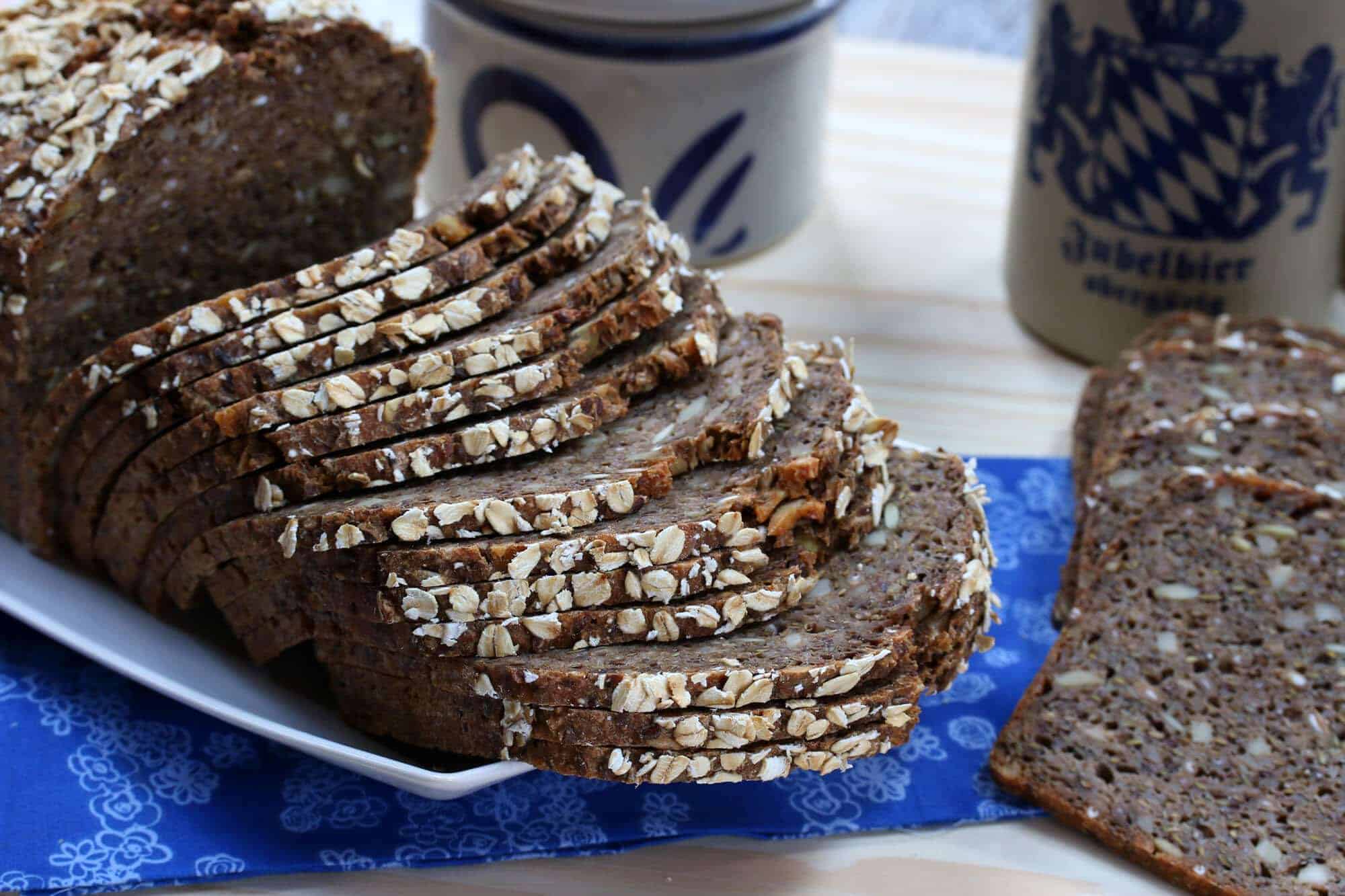
I love breads of all kinds, but there are two kinds that I especially love: Ones that are perfectly crispy on the outside and fluffy on the inside (eg, baguettes) and whole grain breads that are very dense and hearty like the kind I grew up with in Germany (eg, Vollkornbrot, Roggenbrot, Schwarzbrot, etc) and this Danish rye bread.
Smorrebrod
In Germany and throughout Scandinavia dense whole grain breads are particularly popular. You’ll see them served cut up in squares for a variety of hors d’oeuvres (for example, topped with gravlax/smoked salmon, a dollop of crème fraîche or hard-boiled eggs and a sprig of dill), served for breakfast with a tray of sliced cheeses and cold cuts, enjoyed for open-faced sandwiches or simply slathered down with good butter and jam.
In Denmark this rye bread (rugbrød) serves as the basis for their smørrebrød (ie, smorgasbord) wherein it is served buffet style with any number of fine toppings and is also a common accompaniment for many meals. Traditional options include herring, pickled vegetables, liver pate, smoked salmon, and sliced hard-boiled eggs. This Danish Rye Bread recipe is just what you need to create your smorrebrod!
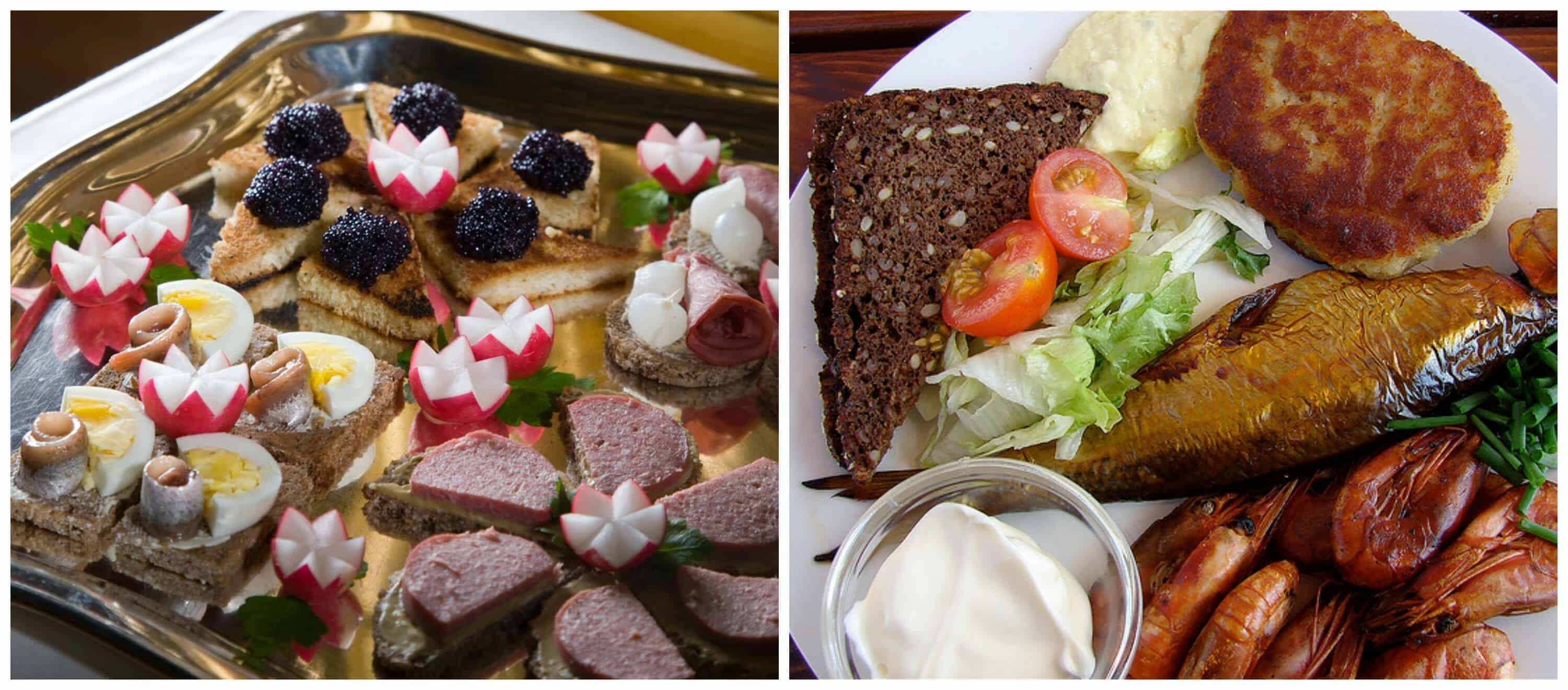
I’ve known many people who have visited Denmark or Germany, fell in love with this type of bread and returned home to their countries unable to find it there. I haven’t been able to find it anywhere here in the U.S. except for German specialty stores and World Market stocks a very small selection of dense German breads. Though specifically Danish sourdough rye bread I haven’t found anywhere here for purchase. The good news is you can make it yourself and I’m going to be posting several recipes for this wonderful style of dense, hearty European bread.
We’re going to start with a favorite among many, Danish Rye Bread. And while this bread is also popular in Germany, it claims particular importance in Denmark, indeed it’s practically one of its national foods, so we’re going to go ahead and ascribe this bread to the Danes. (Plus it will make the maternal side of my husband’s family happy, they’re fiercely proud of their Danish ancestry. And I have some Danish ancestry myself, so we’re all happy.)
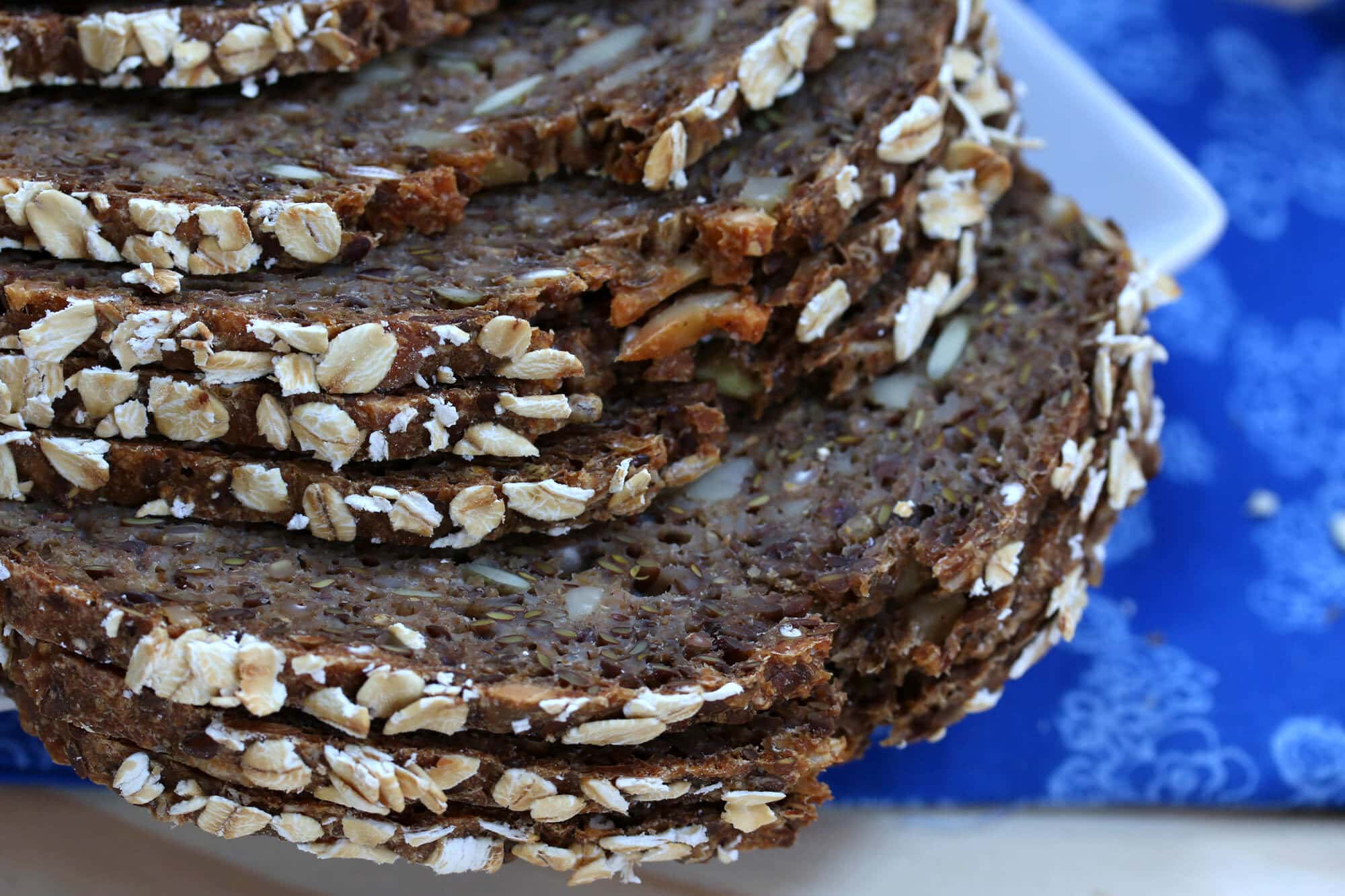
How to Make Danish Rye Bread
Danish rye bread is a sourdough bread that traditionally takes 2-3 days to make. Here is a super simple version that cuts the fermentation time down to as a little as 24 hours without the need to tend and feed it. This version calls for a yeasty beer. Beer and bread are cousins, both traditionally made from the same two ingredients, water and grains. The alcohol in this bread is burned off during the long baking process while the beer contributes to a fabulous texture and consistency (and flavor, depending on which beer you use).
The bread dough is allowed to ferment for 24 hours at room temperature (or 48 hours depending on how sour you like the bread). This fermentation process neutralizes the phytic acid in the grains, a naturally occurring substance that binds nutrients so that the body cannot properly absorb them. Not only does phytic acid acid bind the nutrients of the grains themselves, it binds the nutrients of anything else you eat with the grains. Fermenting the bread dough increases its nutrients and makes the bread easier to digest. And even after sourdough is baked it continues to sour and only gets better in flavor over time.
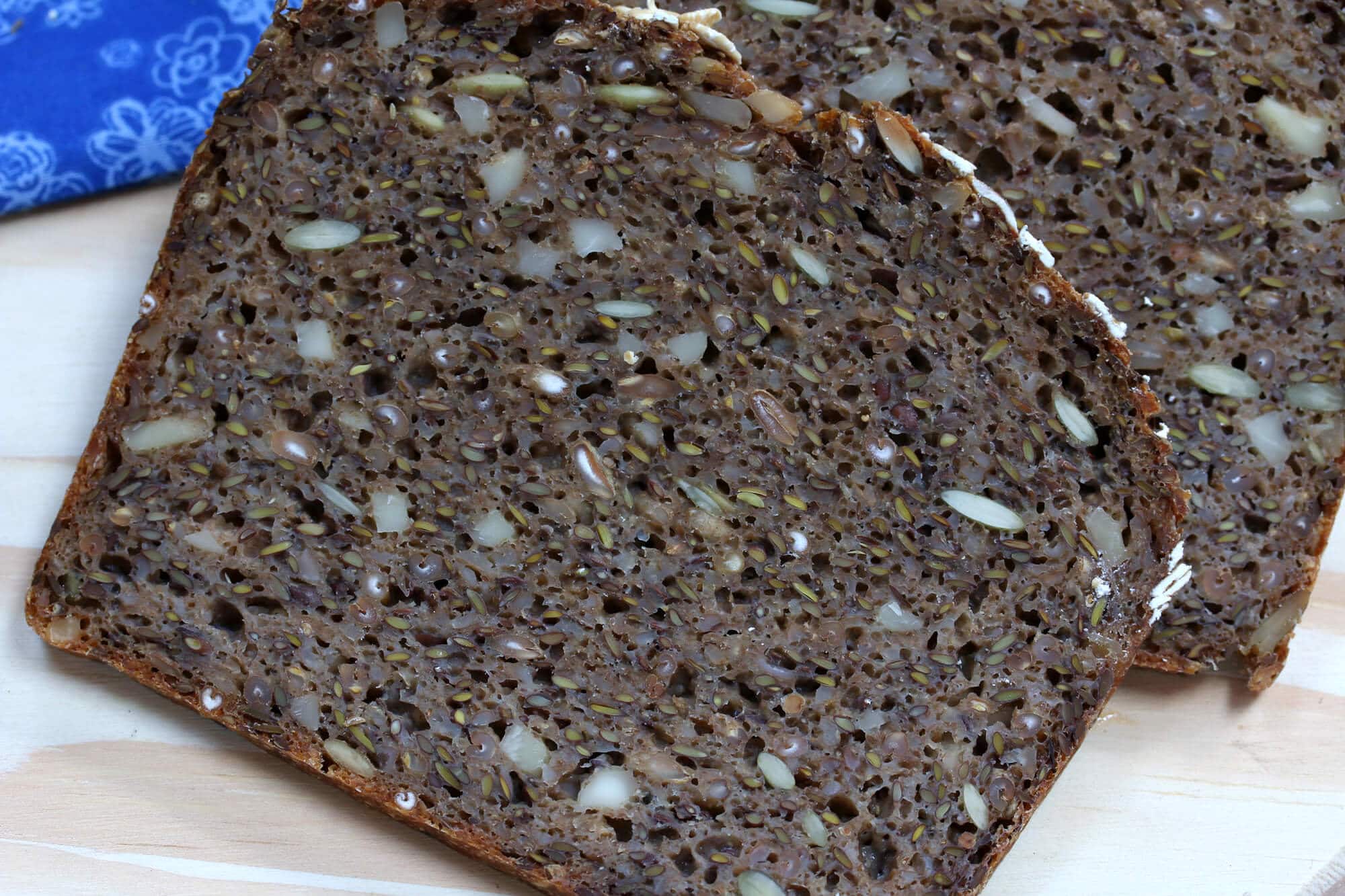
Danish Rye Bread Ingredients
This wonderfully nourishing bread is packed full of whole grains, seeds and nuts. The grains are included in the form of flour (rye and wheat), cracked rye berries and whole rye berries. Tons of similar styled breads incorporate these various forms of whole, cracked, coarsely ground and finely ground grains (eg, spelt, einkorn, wheat, kamut, etc) into the same loaf for a wonderful balance of textures, and that’s where a good grain mill really comes in handy. Not only can you grind your own fresh flour on demand with all the nutrients still intact (as opposed to flour that’s been sitting on grocery store shelves for ages), you can get exactly the kind of grind you need.
I buy my grains all in bulk, take out what I need to last me for a few weeks at a time and store the rest in a dark, cool place. I don’t even buy flour anymore, I grind all of my own flours, cornmeal and make my own baking mixes. For today’s Easy Danish Rye Bread I’m using my German-made KoMo Classic Grain Mill, another stellar example of German engineering and the pride and joy of my kitchen.
With a 12-year warranty, the quality and construction of the KoMo is amazing, plus it’s gorgeous and something you’d want to display on your counter. You can grind your grains as fine or coarse as you like. I use it nearly every day to make my own flours, cornmeal and mixes and cannot recommend it highly enough.
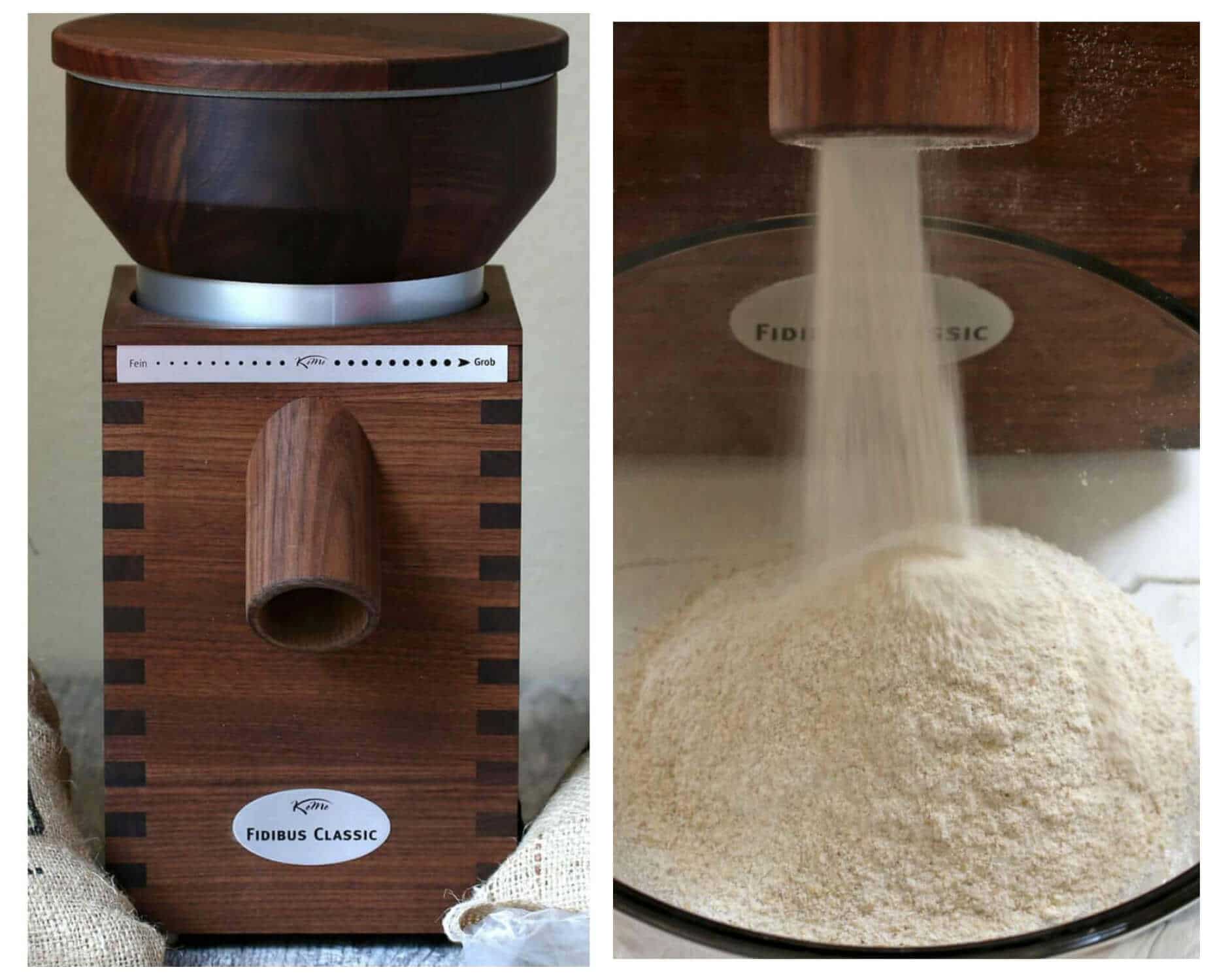
Check out my video below where I talk about some of the KoMo Classic Grain Mill’s features and show it in action in making today’s Danish Rye Bread!
Danish Rye Bread Recipe
Let’s get started!
If you’re grinding your own rye and wheat flour and cracking your own rye berries you’re in great shape! If you don’t have a grain mill you can easily find rye flour in grocery stores and you can “crack” the rye berries yourself by very briefly pulsing them in a good/powerful blender or food processor or smashing them in a bag with a meat mallet or other heavy object.
Combine all of the dry ingredients in a stand mixer bowl. Stir the yeast and sugar into the warm water and let sit for 10 minutes. Add all the wet ingredients to the dry ingredients.
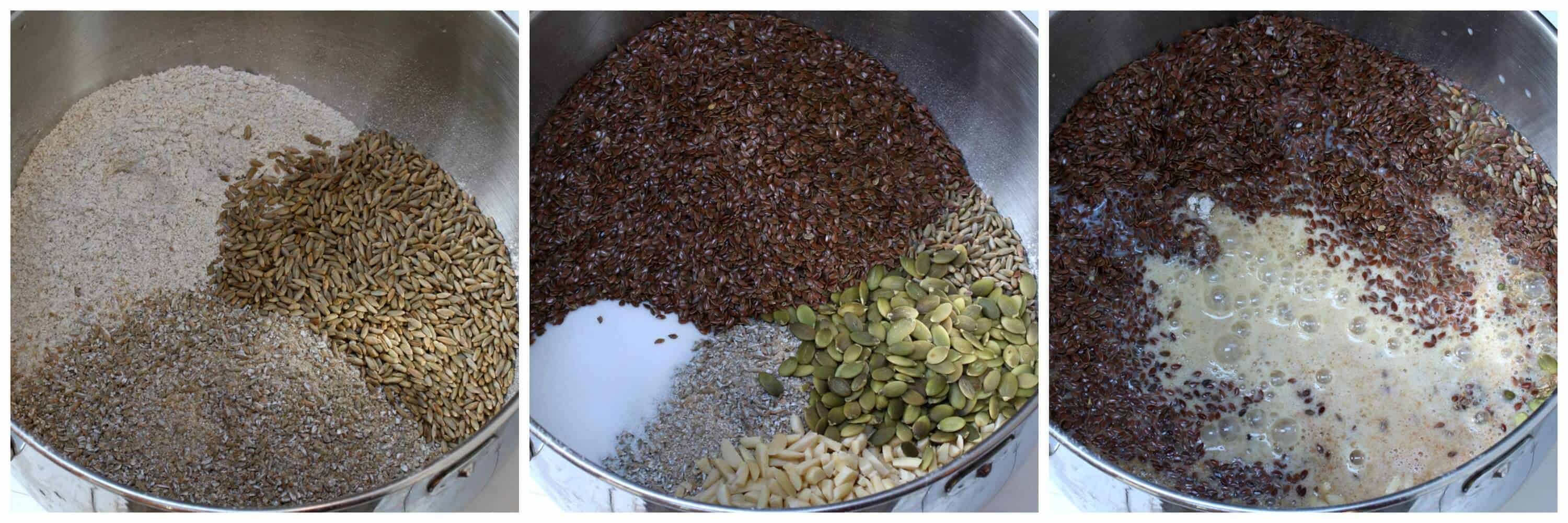
Give everything a stir manually to combine, then attach the dough hook on the stand mixer, set it to the bread setting (#2), and knead for 10 minutes. The dough will be very sticky, loose and not remotely malleable (ie, incapable of being shaped).
Scoop the dough into a very large non-metallic bowl. The dough will bubble up so use a very large, deep bowl with plenty of head room. Cover the dough loosely with plastic wrap and set it in a warm place (ie, room temperature) for 24-48 hours, depending on how sour you want the bread. I’ve done both with great results. If you’re only letting it ferment for 24 hours we recommend first soaking the whole rye berries overnight before using them (drain thoroughly).

After 24 hours the dough will be nice and bubbly with a very gooey texture.
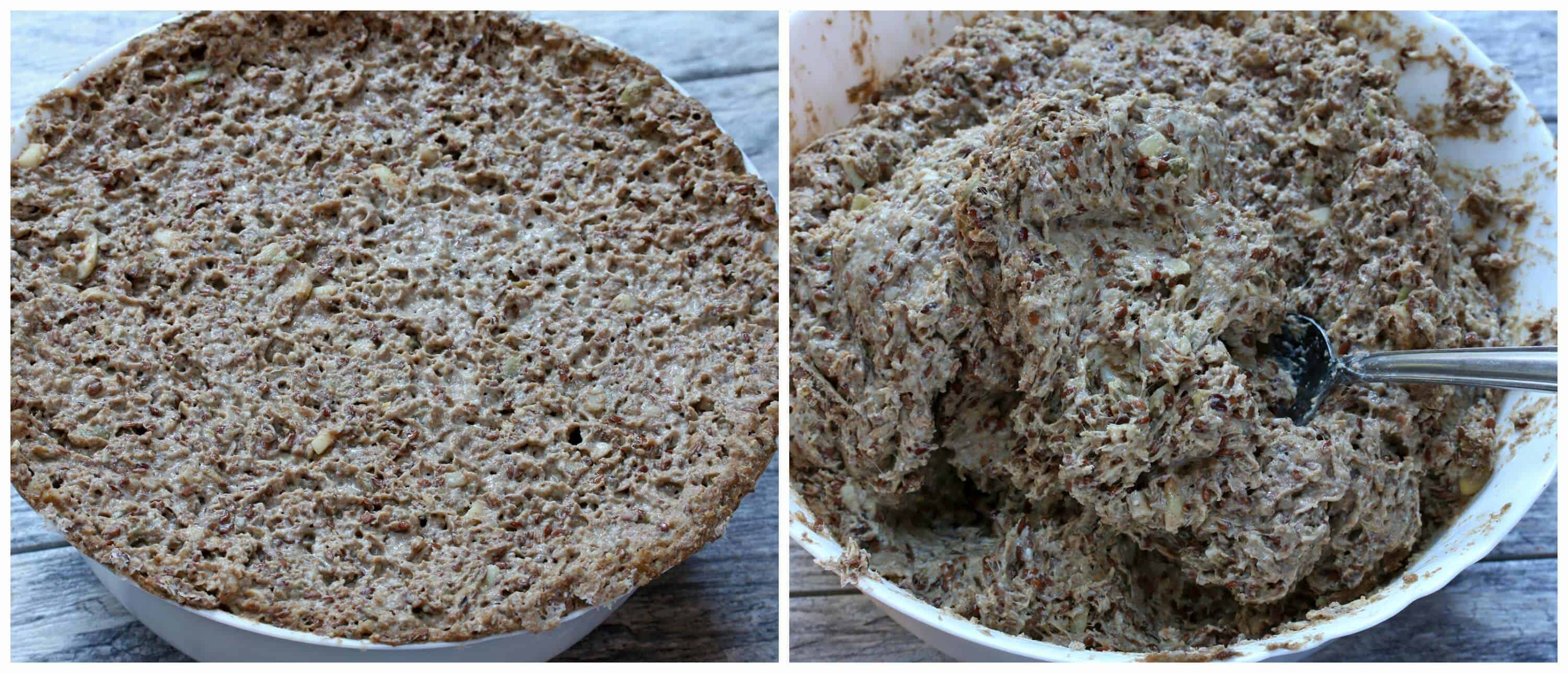
For sourdough it’s recommended that you line your loaf pans so the acid in the dough can’t react with the metal. I use and love the Parrish Magic Line bread pan made of heavy gauge aluminum with straight edges (made in the USA). It’s a 9 x 5 x 3 inch loaf pan.
Scoop all of the dough into the loaf pan, patting it down. It’s a lot of dough but it’ll fit in there, just pat it down (be sure you’re using a 9x5x3 loaf pan). Brush the top with some water and sprinkle some oats evenly over it.

Bake at 350 degrees F for 100-120 minutes or until the center is done. For best and most accurate results use an instant read thermometer and aim for an internal temperature of at least 210 degrees F.
Let it sit for 5 minutes before removing it from the pan. Let the bread cool completely before slicing it. Your rugbrod is ready!
To prolong its shelf life I recommend storing it in the refrigerator or freeze part of it if you know it will take you a while to go through it.
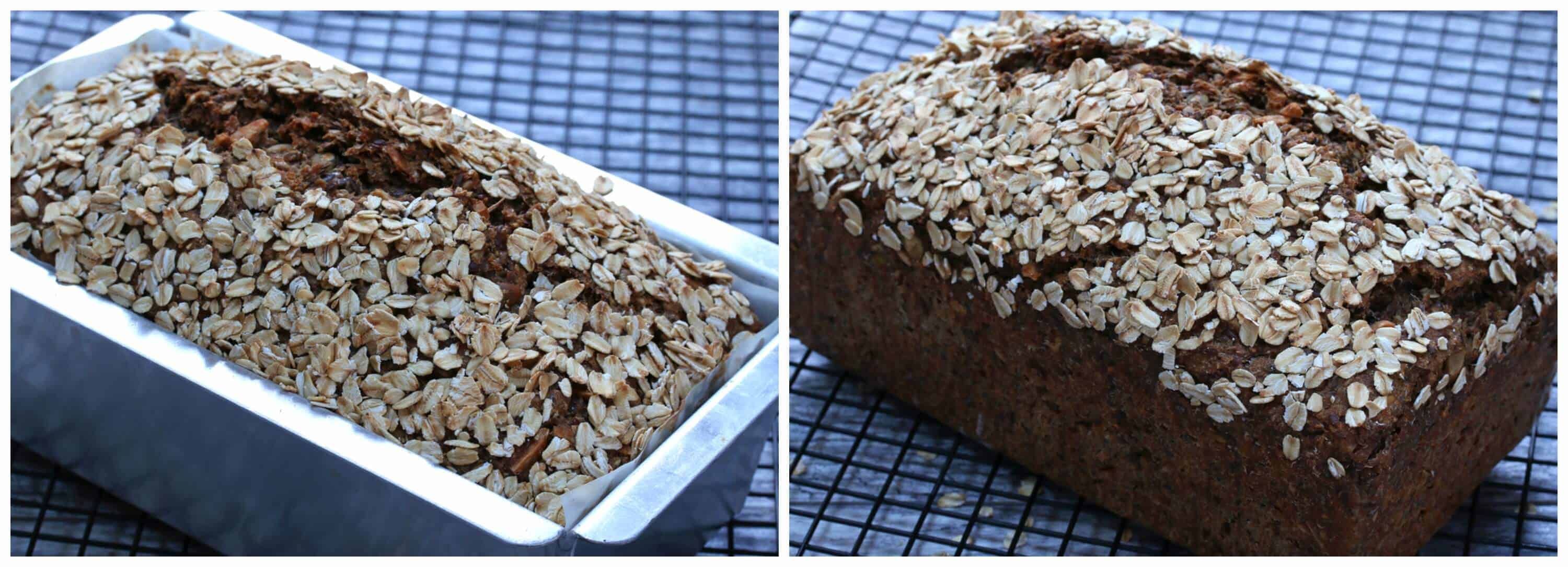
In order to get nice thin, clean slices that look like something you bought at a professional bakery, I recommend a slicer. Chef’s Choice Slicers are consistently ranked at the top and they get excellent reviews. I also use a slicer for meats and cheeses. Whenever I find chunks of cooked ham, turkey or cheese on sale I get those and slice them myself – it’s cheaper than buying them at the deli. At the very least you’ll need an excellent bread knife and for that my favorite knife, hands down, is the Cutco 9 3/4″ Slicer. It glides smoothly through bread and meat like no other.
Enjoy!
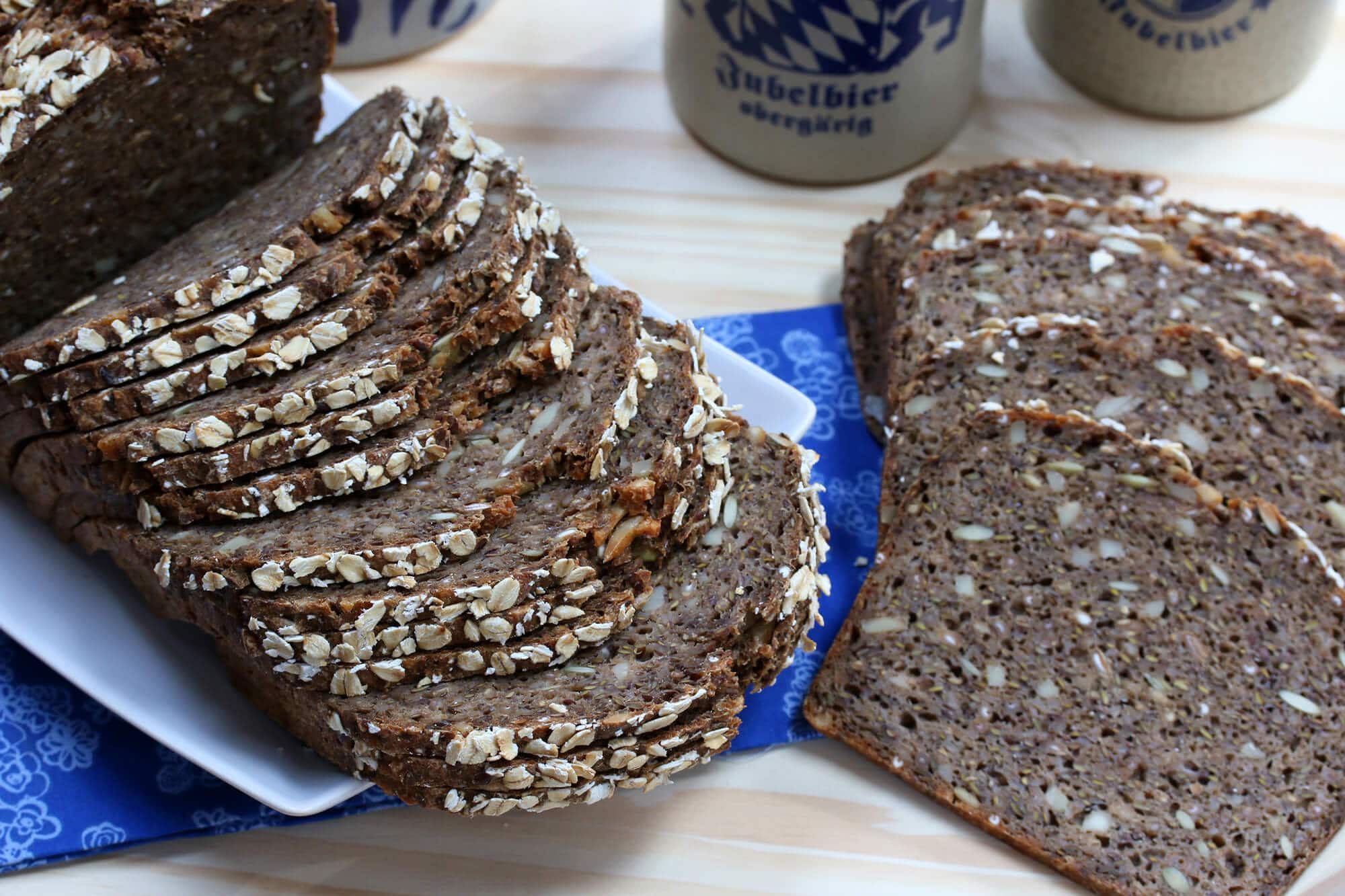
For more delicious breads from around the world be sure to try my:
- German Bread (Vollkornbrot)
- Lavash
- Injera
- Dosa
- Naan Bread
- Sourdough Naan
- Sourdough English Muffins
- Crumpets
- Olive Rosemary Focaccia
- Skillet Cornbread
Save This Recipe
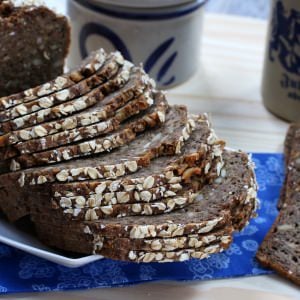
Danish Rye Bread (Rugbrød)
Ingredients
- 2 cups lukewarm water
- 2 teaspoons dry active yeast
- 2 tablespoons sugar
- 2 1/2 cups dark rye flour
- 3/4 cup all-purpose flour
- 1 3/4 cup cracked rye berries (very briefly pulse whole rye berries in a strong blender or food processor until they're broken up into coarse pieces OR smash them in a heavy duty bag with a meat mallet or other heavy object)
- 1/2 cup whole rye berries
- 1 1/4 cup whole flaxseeds
- 1 1/3 cup sunflower seeds or combination of sunflower seeds ,pumpkin seeds and/or chopped almonds
- 3 teaspoons salt
- 1 cup dark beer (see note)
- 1 cup buttermilk or kefir (vegan: 1 cup almond milk mixed with 2 tablespoons cider vinegar) (I often use homemade kefir in place of buttermilk)
- Traditional rolled oats for sprinkling
Instructions
- Stir the yeast and sugar into the lukewarm water and let sit for 10 minutes until the yeast is frothy.
- Combine all the dry ingredients in the bowl of a stand mixer. Add the yeast mixture, beer and buttermilk. Stir to combine.Fit the stand mixer with a dough hook and knead on the bread setting ("2") for 10 minutes. The dough will be very sticky, loose and not remotely malleable (ie, incapable of being shaped).Scoop the dough into a very large non-metallic bowl with plenty of head space (the dough will bubble up). Cover loosely with plastic wrap and let it rest in a warm place (room temperature) for 24-48 hours, depending on how sour you want the bread to be (be sure to ferment it for at least 24 hours to ensure enough of the liquid is absorbed). If you're only letting it ferment for 24 hours we recommend first soaking the whole rye berries overnight before using them (drain thoroughly).
- Line a 9x5x3 inch bread loaf pan with parchment paper (SEE NOTE). Preheat the oven to 350 degrees F.Scoop all of the dough into the lined bread pan, pressing down as needed. (It's a lot of dough but it will fit.) Brush the top with water and sprinkle over evenly with the rolled oats.Bake on the middle rack for 100-120 minutes or until the center is done. For best and most accurate results use an instant read thermometer and aim for an internal temperature of 210 degrees F.Let the loaf cool for 5 minutes before removing it from the pan. Let the loaf cool completely before slicing. Keep stored in an airtight container. To prolong its shelf life I recommend storing it in the refrigerator or freeze part of it if you know it will take you a while to go through it.
Notes
* You can substitute water or more buttermilk for the beer
Nutrition
Originally published on The Daring Gourmet January 28, 2016




















Hi Kimberley,
I have made this recipe on 3 or 4 occasions now and I keep having the same problem, with a large air pocket forming just below the crust.
On the latest occasion, just last night, I have managed to reduce the size of the hole by piercing the loaf 10-15 times just before it goes into the oven.
Would you have any ideas as to why this is happening?
My only remaining ideas are:
– that the crust is forming to quick, so I need to spray the top of the loaf with water before putting it into the oven; or
– the recipe has too much yeast for the warm climate I am in (I live in Sydney, Australia).
Any guidance you could offer would be greatly appreciated. The bread tastes so great, just need to get rid of this pesky hole haha
Thank you,
Michael
Hi Michael, over-proofing in a warm, dry environment is the likely culprit. What you’re describing is known as “flying crust” or “tunnel crust” and there are a few reasons that can happen. Here’s one reference: https://www.quakeroats.com/cooking-and-recipes/content/baking-101/yeast-breads/common-yeast-bread-issues/air-holes-or-tunnels-inside.aspx You did the right thing in de-gassing the dough by piercing it a few times and are already on your way to a perfected loaf. Next time also decrease the proofing time. Good luck!
Thanks so much Kimberly, you are a superstar! I will try those helpful solutions in the link you provided. Hope you have a great week, Michael.
I made the bread and it tastes too salty to me. Is 3teaspoons of salt maybe too much?
I’ve been baking for over ten years and was so excited to try this recipe. I followed the directions exactly. The result was inedible. After two hours in the oven, the bread still wasn’t above 200 degrees. I kept adding time in five-minute increments. When the internal temperature reached 205, after more than three hours I took the bread out of the oven. After cooling it, I cut into it. The center was like pudding. Even after slicing it 1/4 inch and putting the slices in the toaster oven, the center did not cook. An absolute waste of two days time and materials.
That’s really strange. I have made this bread at least 5 times exactly as written and have never had a problem (I LOVE this bread, one of our family’s favorites). The first time the interior was a little on the moist side but that was before I got an instant read thermometer. I also hadn’t let the batter sit long enough. I’ve been baking bread for over 20 years and I will say that this kind of heavy bread utilizing whole and cracked berries in a wet batter is a much different animal than most typical breads and definitely takes some practice to get right. For the inside of your bread to have ben like “pudding” though after more than two hours in the oven just doesn’t makes sense. How many hours did you let the batter sit to allow the grains to soak up the liquid? That step is critical. Still, after over two hours of baking would have firmed up any flour/grain-based mixture, at least to the point of being dry even if not actually sliceable.
Wonderful bread! It’s the first bread I ever baked 😊😂success…
I’m originally from Germany and live in Brooklyn and love these hearty breads. I did add some pine nuts and rosemary and on top some
Hemp hearts. Very very tasty.
I also baked it in my steam oven which was great. Thanks for the awesome recipe
Fantastic, Felicitas, I’m so glad you enjoyed it and I’m super impressed that this was your first bread-baking experience – well done and thanks for the feedback!
Just want to clarify for Anonymous, I do not suggest leaving out 2 cups of lukewarm water, I suggest leaving out one tablespoon of water. My sourdough starter is made up of equal parts flour and water, so when I added 2 tablespoons of starter (in addition to the 2 cups of water, 1 cup of beer, and 1 cup of buttermilk) I actually added more water than the recipe called for. Of course, I also added more flour than the recipe called for (2 tablespoons starter = 1 tablespoon flour + 1 tablespoon water). For someone who wanted to strictly adhere to the hydration of the recipe as written, the solution is to use 3/4 cup AP flour minus one tablespoon AP flour (if using a starter made from AP flour) or to use 2 1/2 cups dark rye flour minus one tablespoon dark rye flour (if using a starter made from rye flour). Make the same adjustment for the water: use 2 cups minus one tablespoon of lukewarm water and keep the amounts of beer and buttermilk the same as written. The addition of the starter barely made an impact on the final hydration, so I did not bother to make the adjustment. I was only suggesting a method to be used if, for some reason, other bakers felt the need to strictly adhere to the hydration of the original recipe.
I’ve made this twice now and really like the sour taste. The first time I followed the recipe exactly as written and the second time I used my sourdough starter. For anyone who is curious, I used 2 Tbsp (30gm) of starter and left the yeast out. I didn’t change anything else since it is such a small addition of flour and water (1 Tbsp or 15gm of each), but you could cut back on the flour by one tablespoon and the water by one tablespoon if you want to be exact about things. The dough sat at room temp in a bowl for about 18hrs and then I put it in a bread pan lined with parchment paper. It was almost another 8 hours before I got around to baking it. Both methods produced great bread, but I’m partial to the sourdough loaf. Next time, I think I’ll use half the sourdough starter (1 Tbsp or 15gm total) and let the dough sit for 48hrs before baking it. I think this is going to be a staple at my house from now on!
That’s wonderful, Mike, I’m so glad to hear it, thank you! Thanks also for the tip on the sourdough starter.
Mike thanks for posting RE using starter.
I would explicitly call out you still need the 2 cups of lukewarm water or you are making some new kind of super concrete… the hydration for the dough is off otherwise.
Hello Kimberly,
I’m new to your blog and thank you so much for your interesting recipes. My mother comes from Schwobalaendle :-) where all my family still lives (Stuttgart, Tuebbingen, Goeppingen, etc.)
I just made your Vollkornbrot and love it. I’m planning to try your Roggenbrot next but have a couple of questions. May I trouble you with them?
1. If I wanted to make this in a large Pullman Loaf Pan (like used for your Vollkornbrot), should I double the recipe to get the right volume to fit the pan? I imagine you have made this also in a Pullman pan?
2. I have a family member who isn’t crazy about the small, crunchiness of the whole flax seeds. If I grind them, would I need to adjust the measurement? Or, what would be a good substitute/adjustment if I left them out of the recipe entirely?
I thank you most sincerely for your time and look forward to your reply at your convenience.
Hi Natalie, I’m so glad you enjoyed the Vollkornbrot, thank you! Oddly enough I haven’t made this in a Pullman pan yet but yes, doubling the recipe should fit the pan. You can substitute the flax seeds with some extra sunflower seeds, cracked rye berrries, and/or pumpkin seeds, chopped almonds, etc. Happy baking! :)
Hi Kimberly
thanks for this wonderful recipe. However mind did not turn out as dark as in the picture, perhaps I can add a bit of molasses next time to get the lovely dark color.
Recipe mentions that the fermentation process will remove the phytic acid, but i was wondering if i could soak the rye berries before adding in. I noticed some of the rye berries were still a bit hard when I tasted the bread.
Looking forward to your future posts.
Hi Elaine, I haven’t tried soaking the berries for this particular recipe and not sure to what extend the additional moisture will impact the final texture. If you give it a try please let us know how it turns out.